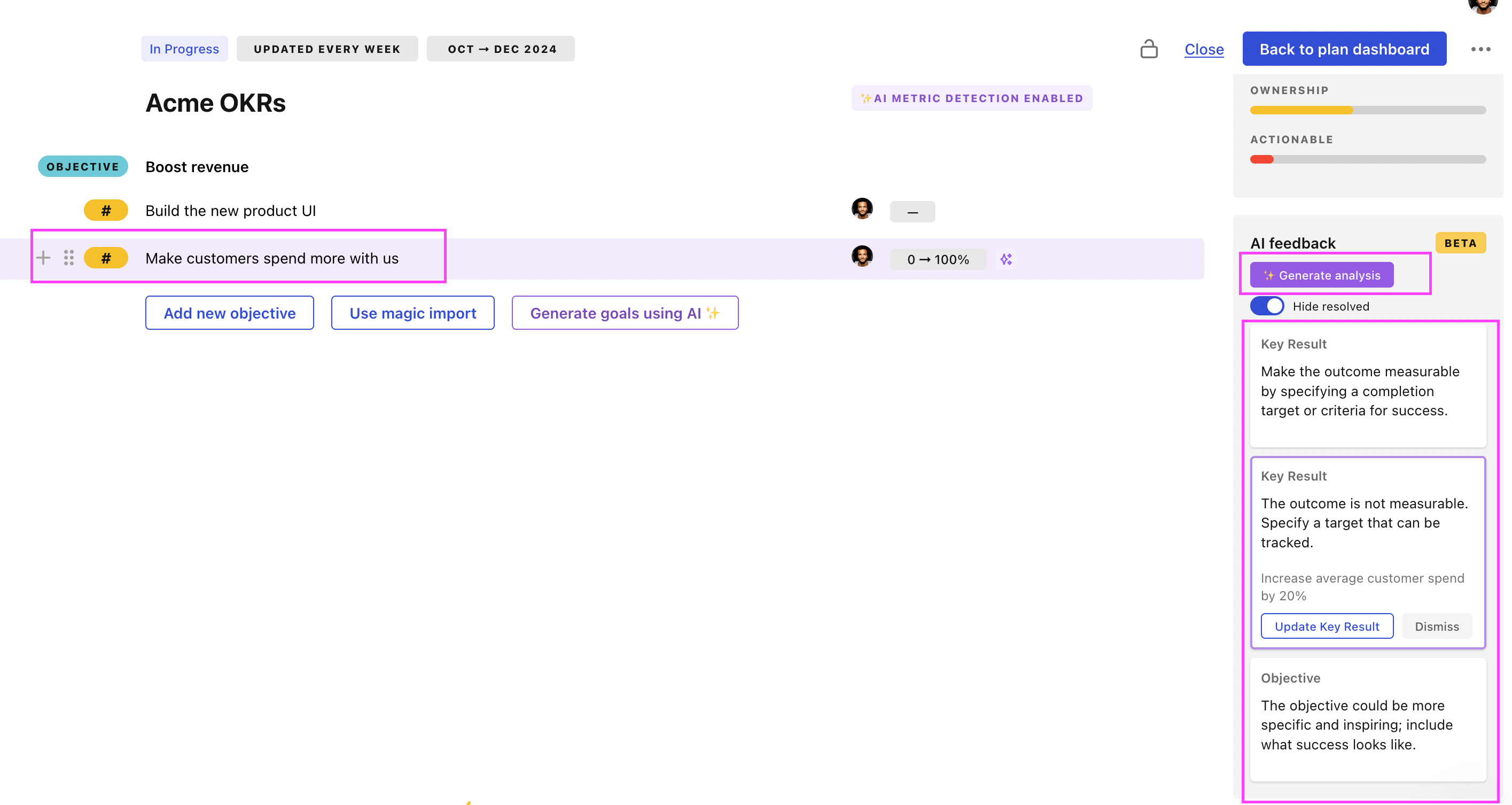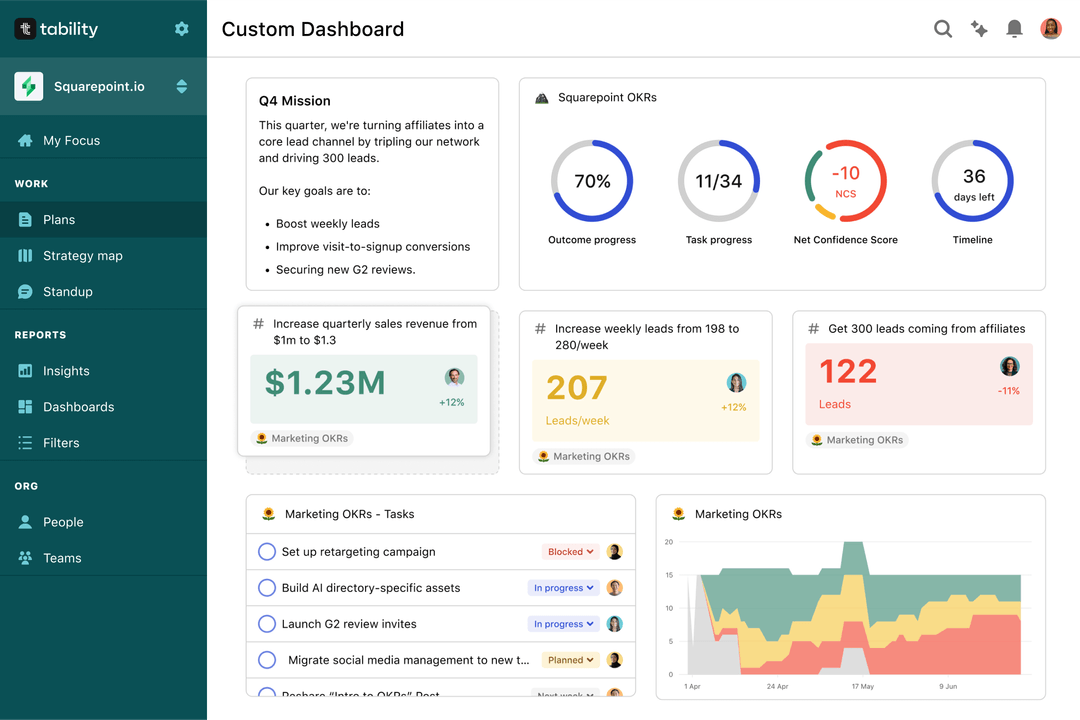Tability is a cheatcode for goal-driven teams. Set perfect OKRs with AI, stay focused on the work that matters.
What are Carbon Footprint OKRs?
The Objective and Key Results (OKR) framework is a simple goal-setting methodology that was introduced at Intel by Andy Grove in the 70s. It became popular after John Doerr introduced it to Google in the 90s, and it's now used by teams of all sizes to set and track ambitious goals at scale.
Creating impactful OKRs can be a daunting task, especially for newcomers. Shifting your focus from projects to outcomes is key to successful planning.
We have curated a selection of OKR examples specifically for Carbon Footprint to assist you. Feel free to explore the templates below for inspiration in setting your own goals.
If you want to learn more about the framework, you can read our OKR guide online.
The best tools for writing perfect Carbon Footprint OKRs
Here are 2 tools that can help you draft your OKRs in no time.
Tability AI: to generate OKRs based on a prompt
Tability AI allows you to describe your goals in a prompt, and generate a fully editable OKR template in seconds.
- 1. Create a Tability account
- 2. Click on the Generate goals using AI
- 3. Describe your goals in a prompt
- 4. Get your fully editable OKR template
- 5. Publish to start tracking progress and get automated OKR dashboards
Watch the video below to see it in action 👇
Tability Feedback: to improve existing OKRs
You can use Tability's AI feedback to improve your OKRs if you already have existing goals.
- 1. Create your Tability account
- 2. Add your existing OKRs (you can import them from a spreadsheet)
- 3. Click on Generate analysis
- 4. Review the suggestions and decide to accept or dismiss them
- 5. Publish to start tracking progress and get automated OKR dashboards

Tability will scan your OKRs and offer different suggestions to improve them. This can range from a small rewrite of a statement to make it clearer to a complete rewrite of the entire OKR.
Carbon Footprint OKRs examples
We've added many examples of Carbon Footprint Objectives and Key Results, but we did not stop there. Understanding the difference between OKRs and projects is important, so we also added examples of strategic initiatives that relate to the OKRs.
Hope you'll find this helpful!
OKRs to lower the carbon footprint of building projects
ObjectiveLower the carbon footprint of building projects
KRDecrease carbon emissions from equipment by 20% through efficient utilization
Train staff for environmentally friendly operation of equipment
Implement energy-saving settings on all equipment
Establish regular maintenance checks for efficiency
KRAchieve 15% improvement in waste recycling efficiency from construction sites
Implement new strategies for efficient waste sorting and recycling
Enforce stricter adherence to waste recycling guidelines by all staff
Perform regular audits of waste recycling procedures on construction sites
KRImplement green sourcing strategy, targeting a 30% increase in eco-friendly materials
Train procurement staff on sustainable sourcing
Develop criteria for green material selection
Identify suppliers producing eco-friendly materials
OKRs to enhance our company's overall sustainability management practices
ObjectiveEnhance our company's overall sustainability management practices
KRReduce company's carbon footprint by 15% through incorporating green energy solutions
Implement a company-wide recycling program to decrease waste
Set up telecommuting options to reduce employee commuting
Install renewable energy systems like solar panels or wind turbines
KRAchieve a 25% reduction in overall energy consumption through energy efficient modifications
Implement a company-wide energy conservation policy
Enhance insulation in walls, ceilings, and floors
Install energy-efficient appliances and light fixtures
KRImplement a recycling program resulting in 20% fewer office waste
Introduce recycling bins and clear signage displaying what can be recycled
Conduct staff training to ensure understanding and compliance with recycling practices
Determine current waste volume to calculate the 20% reduction target
Carbon Footprint OKR best practices
Generally speaking, your objectives should be ambitious yet achievable, and your key results should be measurable and time-bound (using the SMART framework can be helpful). It is also recommended to list strategic initiatives under your key results, as it'll help you avoid the common mistake of listing projects in your KRs.
Here are a couple of best practices extracted from our OKR implementation guide 👇
Tip #1: Limit the number of key results
Having too many OKRs is the #1 mistake that teams make when adopting the framework. The problem with tracking too many competing goals is that it will be hard for your team to know what really matters.
We recommend having 3-4 objectives, and 3-4 key results per objective. A platform like Tability can run audits on your data to help you identify the plans that have too many goals.
Tip #2: Commit to weekly OKR check-ins
Setting good goals can be challenging, but without regular check-ins, your team will struggle to make progress. We recommend that you track your OKRs weekly to get the full benefits from the framework.
Being able to see trends for your key results will also keep yourself honest.
Tip #3: No more than 2 yellow statuses in a row
Yes, this is another tip for goal-tracking instead of goal-setting (but you'll get plenty of OKR examples above). But, once you have your goals defined, it will be your ability to keep the right sense of urgency that will make the difference.
As a rule of thumb, it's best to avoid having more than 2 yellow/at risk statuses in a row.
Make a call on the 3rd update. You should be either back on track, or off track. This sounds harsh but it's the best way to signal risks early enough to fix things.
Save hours with automated Carbon Footprint OKR dashboards

OKRs without regular progress updates are just KPIs. You'll need to update progress on your OKRs every week to get the full benefits from the framework. Reviewing progress periodically has several advantages:
- It brings the goals back to the top of the mind
- It will highlight poorly set OKRs
- It will surface execution risks
- It improves transparency and accountability
We recommend using a spreadsheet for your first OKRs cycle. You'll need to get familiar with the scoring and tracking first. Then, you can scale your OKRs process by using Tability to save time with automated OKR dashboards, data connectors, and actionable insights.
How to get Tability dashboards:
- 1. Create a Tability account
- 2. Use the importers to add your OKRs (works with any spreadsheet or doc)
- 3. Publish your OKR plan
That's it! Tability will instantly get access to 10+ dashboards to monitor progress, visualise trends, and identify risks early.
More Carbon Footprint OKR templates
We have more templates to help you draft your team goals and OKRs.
OKRs to enhance performance and productivity as a business analyst
OKRs to increase search ranking
OKRs to successfully execute and prepare RTM A Pilot for next year
OKRs to enhance understanding of royalty structures in business contexts
OKRs to achieve full adherence to all regulatory compliance standards
OKRs to enhance efficiency and effectiveness of CrowdStrike remediation